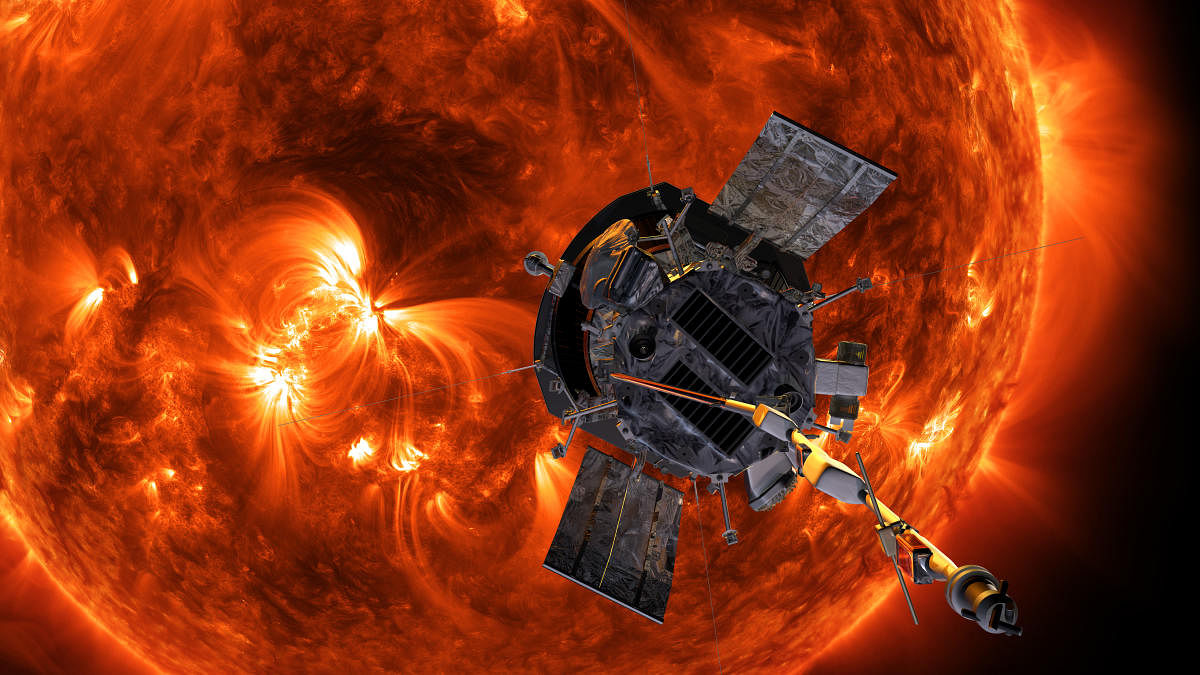Unbeknownst to most, a blazing fast wind is churned in the heated cauldron of the sun’s atmosphere and flows past Earth at speeds reaching a million kilometres per hour. The wind carries the sun’s magnetic fields with it and weaves together a magnetic web inside a plasma bubble known as the heliosphere. The heliosphere is the sphere of influence of the sun, inside which resides the solar system and the only planet known to harbour life, planet Earth.
The sun is made up of extremely hot gas which has been completely ionized, meaning that atoms of elements have been split in to negatively charged electrons and positively charged ions. Motion of these particles inside the sun generates strong magnetic fields which escape through the sun’s surface to form gigantic loops that arch through the solar atmosphere. Turbulent motions below the surface shake the foundations of these magnetic arches generating waves that shoot up to the sun’s upper atmosphere – the Corona.
Energy conversion
Some scientists believe that these waves can be stopped and destroyed in the Corona converting the energy of the waves to heat the sun’s atmosphere to a million degrees. Others believe this heating is better explained by a process known as magnetic reconnection, wherein, oppositely directed magnetic loops come in to contact and violently destroy each other converting magnetic energy to heat energy.
The hot solar atmosphere and the magnetic energy release there are both thought to give birth to the solar wind and sometimes, violent solar storms that create hazardous space weather conditions. Although we have developed theories to understand these exotic processes we have never before been able to travel to the source where these phenomena are born. Who would dare to get that close to the sun?
NASA dared and conceived the Parker Solar Probe, humanity’s first mission to explore the tumultuous innermost sanctum of the solar system and the only mission to be named after a living scientist, Eugene N Parker. It was Parker who first predicted the existence of the supersonic solar wind in 1958, a revolutionary idea first spurned by many of his peers, but soon confirmed by the Soviet satellite Luna at the dawn of the space age. This daring mission took years to design and incorporates a first of its kind heat shield that can withstand temperatures exceeding a few thousand degrees while keeping the temperature of the instruments in its shade at a benign 30 degrees Celsius. The Parker Solar Probe was launched on August 12, 2018 and in its first few orbits moving ever closer to the sun, it has already discovered some surprising things.
In four papers in the December 5th issue of Nature, the first major results from Parker Probe were unveiled. Based on near-Earth observations we believed the solar wind to be more or less uniform and directed predominantly outwards from the sun.
However, Parker Probe has discovered a highly non-uniform wind closer to the sun consisting of tiny regions where particles are suddenly accelerated to much higher speeds. Instead of smooth magnetic field lines pointing outwards, it has found intriguing “switchback” structures akin to two close hairpin bends in which the magnetic field reverses direction towards the sun and then again reverses to point outwards.
This discovery opens up the possibility of magnetic reconnection releasing energy within these tangled magnetic structures which can speed up the wind well beyond the region where they are born, much like a river suddenly gaining speed far away from its source!
Closer look
Parker Probe measured the rotation of the solar wind at distances closer than the orbit of the innermost planet Mercury and found it to be much faster than hitherto thought. The sun rotates and it is no surprise therefore that the wind it spawns has a significant sideways motion close to the sun. Nevertheless, the surprisingly fast solar wind rotation that Parker Probe discovered implies a higher solar angular momentum loss rate which could slow down the sun’s spin faster than theorists imagined.
Conversely, this would mean that the sun was rotating much faster in the past and was therefore more active millions to billions of years ago when primordial life was taking shape on earth. This has tantalising implications for the origin of life in extreme environments. These discoveries, and surely many more to come, would not be possible if we had not dared to go so close to the innermost sanctum of the solar system.
In an uncharacteristically eloquent editorial the Nature journal wrote “In some ways, NASA’s Parker Solar Probe can trace its ancestry to the tale of Icarus, the character from ancient Greek mythology who took flight by donning wings made from feathers and wax.” However, in sharp contrast to the unfortunate circumstances in which Icarus’s flight ended, modern science and technology prowess has ensured a lasting legacy from Parker Solar Probe. The bar has been set high by NASA.
In about a year, ISRO will launch the Aditya-L1 spacecraft, India’s first mission to observe the sun and space weather. Along with NASA’s Parker Solar Probe and European Space Agency’s Solar Orbiter mission scheduled for launch early next year, we are looking at an exciting decade of discoveries about our star and our space environment.
(The author is Professor of Physics at IISER Kolkata and the Principal Investigator of the MHRD Center of Excellence in Space Sciences India)
